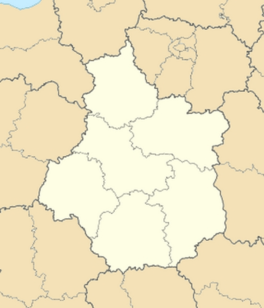Triguères
| Triguères | ||
|---|---|---|
|
The town hall | ||
| ||
 Triguères | ||
|
Location within Centre-Val de Loire region  Triguères | ||
| Coordinates: 47°56′21″N 2°58′54″E / 47.9392°N 2.9817°ECoordinates: 47°56′21″N 2°58′54″E / 47.9392°N 2.9817°E | ||
| Country | France | |
| Region | Centre-Val de Loire | |
| Department | Loiret | |
| Arrondissement | Montargis | |
| Canton | Château-Renard | |
| Government | ||
| • Mayor (2001–2007) | Michel Raigneau | |
| Area1 | 35.78 km2 (13.81 sq mi) | |
| Population (2012)2 | 1,332 | |
| • Density | 37/km2 (96/sq mi) | |
| Time zone | CET (UTC+1) | |
| • Summer (DST) | CEST (UTC+2) | |
| INSEE/Postal code | 45329 / 45220 | |
| Elevation | 112–192 m (367–630 ft) | |
|
1 French Land Register data, which excludes lakes, ponds, glaciers > 1 km² (0.386 sq mi or 247 acres) and river estuaries. 2 Population without double counting: residents of multiple communes (e.g., students and military personnel) only counted once. | ||
Triguères is a commune in the Loiret department in north-central France.
Geography
The commune is traversed by the Ouanne River.
History
Standing on the path from Orleans to Troyes - a major road from prehistoric times until the beginning of 19th century -, Triguères has provided many important prehistoric, Celtic and Roman remnants of its rich past.
Mousterian settlements
In 1922 a large Mousterian site was discovered at La Garenne. The artefacts found there, date from the end of acheulean tradition (from 500,000 to 300,000 y.a.) to the end of mousterian (30,000 y.a.).[1]
Celtic times
A Celtic oppidum over 22 acres wide stood on the hill north of the river, surveilling the « chemin Perré » ("stone path") where flint stones were used according to the Celtic method, and not stone slabs as per the Roman method.[2]
Roman period
Triguères is a choice candidate for being the Vellaunodunum mentioned by Julius Caesar's in Commentarii de Bello Gallico.[2][3][4] The remnants of a large Gallo-Roman town were found in the 1850-1860, notably an amphitheatre,[2][Note 1] a cemetery in 1857,[5] a source sanctuary at the moulin du Chemin in 1858,[5][Note 2] Gallo-Roman villas at les Vallées and les Monts,[Note 3][Note 4] a Gallo-Roman temple,[2] an aqueduct and two public Roman baths.[2]
Greater Triguères entirely disappeared in 451 when Attila passed through the valley, coming from Orleans which he failed to take (his first major drawback in his campaign) and on his way to a full defeat at the battle of the Catalaunian Plains.[2] Triguères waited for six centuries to start its rebirth, and it never recovered its former splendour.[5]
Middle Ages
Saint Alpais of Cudot and his legend precede Triguères' rebuilding, along with the Christian expansion. Saint-Martin church dates back from the end of 11th century.
The Chatelet house was built in 1550.
Saint-Martin church seen from the south-east Roman porch, Saint-Martin church, Triguères Reliquaries of Saint-Martin church in Triguères
See also
References
- Notes
- ↑ Coordinates of the amphitheatre: 47°56′29.45″N 2°58′48.26″E / 47.9415139°N 2.9800722°E. It is still clearly visible in aerial photographs. Even though a house was built there, the relief of its large semi circle figure unmistakably shows on local maps with altitude lines.
- ↑ Coordinates of the moulin du Chemin: 47°56′18.88″N 2°58′48.98″E / 47.9385778°N 2.9802722°E.
- ↑ Coordinates of lieu-dit Les Vallées: 47°55′55.73″N 2°58′21.75″E / 47.9321472°N 2.9727083°E
- ↑ Coordinates of lieudit Les Monts: 47°56′7.13″N 2°57′2.28″E / 47.9353139°N 2.9506333°E
- Références
- ↑ (French) La station moustérienne de la Garenne, commune de Triguères (Loiret). Aurèle Chevillon, Bulletin de la Société préhistorique de France, volume 47, n° 6-8, 1950, pages 372-375.
- 1 2 3 4 5 6 (French) Nouvelle étude sur les ruines celtiques et gallo-romaines de la commune de Triguères. Eugène Boutet de Monvel. Mémoire de la Société d'Agriculture, Sciences, Belles-Lettres et Arts d'Orléans, tome 7, 1863, pages 137-172
- ↑ M.A. Bréan, Itinéraire de l'expédition de César, 1865.
- ↑ (French) Étude sur les expéditions de Jules César dans les Carnutes. Eugène Boutet de Monvel. Mémoire de la Société d'Agriculture, Sciences, Belles-Lettres et Arts d'Orléans, tome 7, 1863, pages 5-102.
- 1 2 3 (French) Histoire d'il y a belle lurette..., Triguères. Liliane Violas, L’Éclaireur du Gâtinais n° 2780, 11 february 1999.
| Wikimedia Commons has media related to Triguères. |
.svg.png)